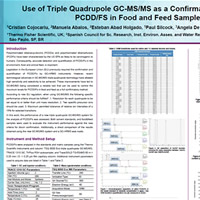
USE OF TRIPLE QUADRUPOLE GC-MS/MS AS A CONFIRMATORY METHOD FOR PCDD/FS IN FOOD AND FEED SAMPLES Cristian Cojocariu (1), Manuela Abalos (2), Esteban Abad Holgado (2), Paul Silcock (1), Angela De Pietro (3) (1)Thermo Fisher Scientific,UK; (2)Spanish Council for Sc. Research, Inst. Environ. Asses. and Water Research, ES, (3)Nova Analítica São Paulo, SP, BR |
Resumo do Pôster:Polychlorinated dibenzo-p-dioxins (PCDDs) and polychlorinated dibenzofurans (PCDFs) constitute a group of highly toxic organic compounds formed unintentionally, mainly in waste combustion processes or as by-products of industrial manufacturing of certain chemicals, such as chlorinated pesticides. PCDD/Fs can enter the food chains where they persist and bioaccumulate. Human exposure to dioxins occurs mostly from ingesting contaminated food. PCDD/Fs have been characterized by the US Environmental Protection Agency as likely to be carcinogenic to humans even at background levels of exposure. Consequently, accurate detection and quantification of PCDD/Fs in the environment, particularly in food and animal feed, is important. Legislation in the European Union previously required the confirmation and quantification of PCDD/Fs in contaminated samples by gas chromatography/high resolution mass spectrometry (GC-HRMS) instruments, considered the “gold standard” approach. However, recent technological advances in gas chromatography/triple-quadrupole mass spectrometry (GC-MS/MS) technology have allowed high sensitivity and selectivity to be achieved. These improvements have led to GC-MS/MS being considered a reliable tool that can be used to control the maximum levels for PCDD/Fs in food and feed as a full confirmatory method. According to new EU regulation, when using GC-MS/MS the following specific performance criteria for dioxin confirmation with GC-MS/MS technology should be fulfilled in addition to the criteria described previously by the European Commission (except the obligation to use GC-HRMS): 1. Resolution for each quadrupole to be set equal to or better than unit mass resolution; 2. Two specific precursor ions should be used; 3. Maximum permitted tolerance of relative ion intensities of ± 15% for selected transitions. In this work, the performance of a new triple quadrupole GC-MS/MS system for the analysis of PCDD/Fs was assessed. For this, both solvent standards, and food and feed samples were used to evaluate the instrument performance against the new criteria for dioxin confirmation. Additionally, a direct comparison of the results obtained from food and feed sample extracts using the new GC-MS/MS system with those from a GC-HRMS was made. The results demonstrate that the system is highly sensitive and selective for confidently use for PCDD/Fs detection and confirmation in food and feed samples. The reproducibility, linearity, sensitivity, and selectivity data were obtained in all the experiments performed with standards and sample extracts. The authors thank Brock G. Chittim from Wellington Laboratories Inc. for providing the EPA 1613 calibration standards. |
